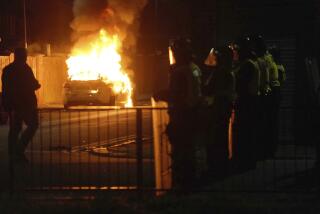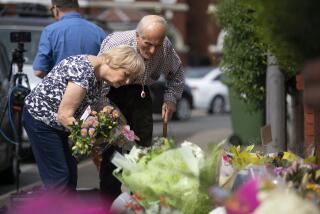British Cities Under Siege by Young Thugs
LONDON â Canning Town grew up as a Victorian-era slum, home to a caustic stew of noxious factories and cramped houses backing up to open sewage ditches. Some believe it was an inspiration for Charles Dickensâ portraits of London childhoods too miserable to produce anything but thieves.
Things havenât changed much, if you ask Alex Jackson, a longtime resident of the East London neighborhood.
Jackson said he was accosted recently outside a market by three or four boys who he guessed were between 10 and 14 years old.
âOne of the kids says to me, âGet us some cigarettes, will you?â And I tell him, âYouâre not old enough to smoke.â And I kept going. On my way out, about 10 yards out, I get from one of them, excuse the language, âYou [expletive] bald-headed old [expletive], Iâm gonna stab you.â Iâm not kidding. Itâs an everyday occurrence.â
The neighborhood made headlines last year when DHL, the worldwide courier service, allowed its drivers on occasion to opt out of deliveries to Canning Town.
âThey deliver in Beirut. They wonât deliver in E16,â Jackson said, referring to the postal code here.
One only has to step off the train into this dockside neighborhood across the Thames River from the money-soaked Canary Wharf district to understand how street crime has become an issue even tougher than terrorism for Prime Minister Tony Blairâs Labor Party.
The government has poured major resources into dozens of investigations of homegrown Islamic extremists. But the more immediate, day-to-day reality in parts of many British cities is that going to the market or dropping children off at school can involve running a gantlet of young thugs whose numbers and audacity appear to have largely overwhelmed the police in areas such as Canning Town.
The gun homicide rate in England and Wales is 40 times less than the U.S. rate, but statistics showed an increase of more than one-third in shootings in London between April 2005 and March, the Metropolitan Police Service said. The numbers have gone down slightly since then.
Much of the problem, police say, can be attributed to an increasing number of teenagers carrying guns and using them to settle minor scores.
The Metropolitan Police Service has seen an increase in teenage criminals compared with previous years, said a spokeswoman, who, in accordance with police protocol, spoke on condition of anonymity. âThe youngest charged during the last year has been 14 years old. Clearly, this situation is unacceptable and a cause for concern.
âIt appears that a small minority of young people think it is more socially and morally acceptable to carry guns than in the past,â she said. âOffenders are resorting to using firearms over trivial disputes like arguments over spilt drinks, bumping into one another or minor road collisions.â
In the case of Peter Woodhams, a 22-year-old satellite technician who lived with his fiancee and their 3-year-old son on a cul-de-sac in Canning Town, the âtrivial disputeâ started with a stone hurled at his new Ford Escort.
For months, Woodhams would drive home from work and a group of teenagers lounging by the road would throw a rock into the side of his car. In January, he confronted the boys. They pushed him to the ground and stabbed him quickly and expertly in the neck, just missing an artery.
After that, the boys would taunt Woodhams when he passed. On one occasion, a boy caught Woodhamsâ eye and drew a finger across his neck.
âEvery time we drove out, they were there at the corner. Theyâd point and theyâd like intimidate us,â said Woodhamsâ fiancee, Jane Bowden, a nursery school teacher and his girlfriend since high school.
Woodhams called the police regularly. He and Bowden gave officers a description of the teens and also passed on the name and address of the gangâs leader, which was given to them by an anonymous caller.
Gradually, however, they stopped calling police.
âThey said, âWe canât go on hearsay,â â Bowden said.
Then late last month, it happened again. Woodhams went to the store after dinner, leaving Bowden and their son in their small apartment. He had been gone only a short time when he rushed back in, threw his car keys on the table and ran out. They were at it again, he told Bowden. He was going to take care of it.
The next thing she heard were gunshots. She found Woodhams not far from where he had been soaked in blood months earlier. This time, he was dying.
Woodhamsâ months of calls to police got lost in the mayhem that is Canning Town, where crime statistics buck Londonâs overall trend toward lower crime rates.
In Newham, the 14-square-mile borough that includes Canning Town, there were an average of 11 burglaries a day for the year through July. Assaults averaged 22 a day, robberies seven.
Canning Town is the target of a $3.2-billion renovation program timed to coincide with the 2012 Olympics in London. Many of the sporting events will be held nearby.
In the meantime, it remains one of Britainâs most deprived communities, afflicted by poor healthcare, low education and poverty. About 50% of its working-age adults have no formal qualifications.
At a tiny liquor store near where Woodhams was attacked, the owner keeps a clerk at the front door, a second one in the middle of the store and a third behind the counter to intercept groups of youths who regularly swarm in and pilfer beer.
The owner, who said he was afraid of reprisals if he gave his name, said his shop window had been shattered at least 20 times in the last three years. He has stopped calling his insurance company, which threatened to cancel his policy if he submitted more claims, and the police, who told him to call his insurance agent.
In Canning Town, many people know who killed Woodhams, but they arenât talking to police. Dozens of Woodhamsâ customers have sent cards and flowers, apparently in remembrance of the few minutes he was in their homes installing satellite hookups.
A 14-year-old boy was arrested in both attacks on Woodhams and released on bail, but police hope to collect enough evidence to charge the gangâs ringleader.
Authorities last week asked for the publicâs help in tracking down 18-year-old Bradley Tucker, identified as the key suspect in Woodhamsâ slaying. No one has stepped forward to help find Tucker, who disappeared on the day of the killing.
âSo many people saw that incident, but thereâs a reason nobodyâs cooperating,â one shopkeeper said. âPeople are afraid. They feel threatened themselves.â
Metropolitan Police Service Deputy Commissioner Paul Stephenson said the investigation of the first attack on Woodhams was unacceptable, and he ordered a review of all outstanding investigations of serious assaults in London.
âItâs not just this particular area of London. Itâs all over,â said Paul Schafer, a Canning Town councilman. âItâs something thatâs been happening for the past number of years, where reported crime is getting less and less because youâve got such a major amount of work to go through.
âIf you report your car being smashed or stolen, the first thing they want you to do is take time off work and stand for hours in the police station trying to report it. So what happens is the perpetrators of the crime feel like they can go out and do whatever they want to do, and they know they can get away with it.â
Schafer said police blanketed the neighborhood with fliers looking for witnesses to Woodhamsâ slaying.
âWell, they should be asking their own team, not the public,â he said. âIf the public wanted to tell you, they would have told you. In the end, I donât see any detection. Where is the murderer? Why havenât they caught him? Is he here? Is he in another country? ... Are they actually lost as to where to start?â
Woodhamsâ father, also named Peter, said he had lived most of his life in East London. It was always a rough place, he said, but not like now.
âMy son didnât have a privileged life,â he said. âI mean, weâre not rich. I had five kids, and you canât afford to give them everything when youâre like that, but he had a good life. He was taught the difference between right and wrong and respect for people.
âHe used to say, âIt works. If you show people respect, most people show you respect back. And it becomes a nice world.â â
More to Read
Sign up for Essential California
The most important California stories and recommendations in your inbox every morning.
You may occasionally receive promotional content from the Los Angeles Times.










